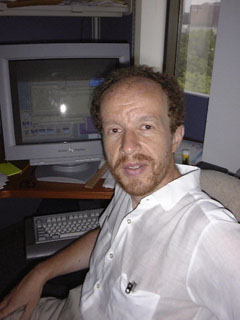The next Step: Exploring the Proteome:
Translation and Beyond
Phylogenomics of Protein Domains
Eugene V. Koonin, Senior Investigator
Computational Biology Branch, NCBI, NLM, NIH


In addition to fundamental insights into the evolution of the protein world, phylogenomics provides specific input for structural and functional genomics. An important contribution of comparative studies to functional genomics is “guilt by association”, prediction of protein function on the basis of domain fusion or gene juxtaposition in prokaryotic genomes. In this lecture I will try to present an overview of the fundamental and more practical aspects of phylogenomics of proteins and domains.
PRINCIPAL RESEARCH GOALS Comparative analysis of sequenced genomes and automatic methods for functional annotation of newly sequenced genomes. Prediction of protein functions. Genome evolution; reconstruction of ancestral life forms and large-scale evolutionary scenarios. Methods for protein motif identification and fold recognition; construction of systematic motif libraries.
EDUCATION AND TRAINING
1973-1978 Virology Branch., Department of Biology, Moscow State University
Biology diploma /equiv.of M.Sc./, 1978
Summa cum laude
Supervisor: Professor V. I. Agol
"A comparative study on the UV resistance of single-stranded and
double-stranded RNA of encephalomyocarditis virus: Evaluation of the possible
contribution of host-mediated repair".
PhD - Department of Biology, Moscow State University, 1983
Supervisor: Professor V. I. Agol
"Multienzyme organization of encephalomyocarditis virus replication complexes"
PROFESSIONAL EXPERIENCE:
1996- Senior Investigator, National Center for Biotechnology Information,
National Library of Medicine, N.I.H., Bethesda, MD
11/15/1991-1996 Visiting Scientist, National Center for Biotechnology
Information, National Library of Medicine, N.I.H., Bethesda, MD
02/1991-05/1991 Visiting Scientist, Biology Department, Texas A&M University,
College Station, TX
1990-1991 Head, Laboratory of Gene Systematics and Bacterial Evolution,
Institute of Microbiology, USSR Academy of Sciences
1989-1990 senior research scientist, Laboratory of Bacterial Genetics,
Institute
of Microbiology, USSR Academy of Sciences
1986-1988 senior research scientist, Laboratory of Virus Biochemistry,
Institute
of Poliomyelitis, USSR Academy of Medical Sciences
1983-1985 research scientist, Laboratory of Virus Biochemistry, Institute of
Poliomyelitis, USSR Academy of Medical Sciences
Honors and awards
2001 Editorial Board, Archaea
2000-present Editorial Board, Nucleic Acids Research
1999 National Library of Medicine Board of Regents Award
1999 Guest Editor, "Current Opinions in Genetics and Development Genomes and
Evolution"
1999 Co-organizer, Cold Spring Harbor Laboratory Workshop on Computational
Biology Bridging the Gap Between Sequence and Function, Cold Spring Harbor,
Sept 7-9
1999-present Editorial Board, Bioinformatics
1998-present Editor of the "Genome Analysis" section, Trends in Genetics
1997-present Associate Editor, In silico Biology
1997, 1999, 2001 Co-Chair of the Program Committee, Conference on In Silico
Biology, Atlanta, GA.
1995 Georgia Institute of Technology Phi-Beta-Kappa Award for the best
research paper of the year
1993-1999. Member of the Executive Committee, International Committee for
Taxonomy of Viruses
1992. Guest Editor, Seminars in Virology - Evolution of Viral Genomes
Editorial Boards: Nucleic Acids Research, Genome Biology, Bioinformatics
Peer review of manuscripts for Nature, Nature Genetics, Science, Cell, Trends
Biochem. Sci., J. Mol. Biol., Nucleic Acids Res., Proteins etc.
Invited lectures and seminars (a selection of talks given in 1998-1999):
11/09/1999 The 11th NAS Symposium Frontiers of Science, Irvine, California
Invited lecture "Comparative genomics and its effect on our understanding of
evolution"
8/24/1999 8th Congress of the European Society for Evolutionary Biology,
Barcelona, Spain. Invited talk "Horizontal gene transfer: evidence and role in
the evolution of prokaryotes"
8/7/1999 Intelligent Systems in Molecular Biology-99, Heidelberg, Germany.
Keynote lecture "Comparative genomics: Is it changing the paradigm of
evolutionary biology?"
7/13/1999 International Society for the Study of the Origins of Life-99
meeting, San Diego, CA. Plenary lecture "How far back can we see through
genome comparison?"
12/11/1998 Genome Informatics Workshop, Tokyo, Japan
Invited talk "Comparative Genomics: Is it changing the paradigm of
evolutionary biology?"
10/07/1998 - NIH Research Festival, NIH, Bethesda, MD
Plenary lecture "The minimal set of genes required to form a cell"
04/17/1998 NIH Director's Seminar Series, NIH, Bethesda, MD
"Complete genomes of cellular life forms the first major lessons from
comparative analysis"
SELECTED BIBLIOGRAPHY (2000-2001). A selection from ~300 peer-reviewed and
invited articles.
Peer-reviewed papers:
International Human Genome Sequencing Consortium (2001). Initial sequencing and analysis of the human genome.
Nature 409, 860-921.
Aravind L, Dixit VM, Koonin EV (2001). The programmed cell death molecular
machinery: genome comparisons show vastly increased complexity in vertebrates.
Science 291, 1279-1284.
Tatusov RL, Natale DA, Garkavtsev IV, Tatusova TA, Shankavaram UT, Rao BS,
Kiryutin B, Galperin MY, Fedorova ND, Koonin EV. (2001) The COG database: new
developments in phylogenetic classification of proteins from complete genomes.
Nucleic Acids Res 29: 22-28.
Uren AG, O'Rourke K, Aravind L, Pisabarro TM, Seshagiri S, Koonin EV, Dixit
VM. (2000) Identification of Paracaspases and Metacaspases: two ancient
families of caspase-related proteins, one of which plays a central role in
MALT lymphoma. Mol. Cell. 6: 961-967.
Aravind L, Watanabe H, Lipman DJ, Koonin EV. (2000) Lineage-specific loss and
divergence of functionally-linked genes in eukaryotes. Proc Natl Acad Sci U
S A 97: 12068-12073.
Uhlmann F., Wernic D., Poupart M-A, Koonin EV, Nasmyth K. (2000) Cleavage of
cohesin by the CD-clan protease separin triggers anaphase in yeast. Cell 103:
375-386.
Wolf YI, Kondrashov FA, Koonin EV. (2000) No footprints of primordial
introns in a eukaryotic genome. Trends Genet. 16: 333-334.
Boja O, Suzuki MT, Aravind, L, Koonin EV, Hadd A, Nguyen LP, Jovanovich SB,
Gates C, Feldman RA,. DeLong EF. (2000) Bacterial Bacteriorhodopsin: Evidence
for Light-Driven Proton Pumping in the Sea. Science 289: 1902-1906.
Grishin NV, Wolf YI, Koonin EV (2000) From complete genomes to measures of
substitution rate variability within and between proteins.Genome Res.
10:991-1000.
Wolf YI, Grishin NV, Koonin EV. (2000) Estimating the Number of Protein Folds
and Families from Complete Genome Data. J. Mol. Biol. 299: 897-905.
Koonin EV, Aravind L, Hofmann K, Tschopp J, Dixit VM (1999) Apoptosis.
Searching for domains in FLASH. Nature 401: 662.
Reviews:
Koonin EV, Aravind L, Kondrashov AS. (2000) The impact of comparative genomics
on our understanding of evolution. Cell. 101:573-6.
Galperin MY, Koonin EV. (2000) Tell me who is your neighbor... New
computational approaches in functional genomics (review). Nature Biotechnol.
18: 609-613.